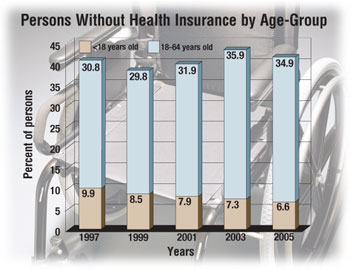US
Pharm. 2006;3:7.
The number of uninsured
children is declining.
According to the
early release of January to June 2005 estimates of the National Health
Interview Survey, 14.4% (41.8 million) of people in the United States did not
have health insurance. Of those younger than 65, 16.2% (41.5 million) were
uninsured; 19.2% of those ages 18 to 64 (34.9 million) and 8.9% of those
younger than 18 (6.6 million) had no insurance.
From 2004 to June 2005, there
was no significant change in the percentage of uninsured working-age adults
(19.3% vs. 19.2%, respectively); however, the percentage of uninsured people
younger than 18 years has continued to decline since 1997 (from 18.1% in 1997
to 12.7% in 2004 and to 12.6% in the first half of 2005).
Working-age adults were almost
twice as likely to lack health coverage as were those younger than 18 years
(23.4% and 12.6%, respectively). During the first six months of 2005, 11.5% of
those younger than 65 (29.4 million) had been uninsured for more than a year
(14.1% of adults and 5.2% of children). Among adults ages 18 to 64, the
percentage of those uninsured for more than a year increased from 12.3% in
2001 to 14.1% in the first half of 2005. The percentage of children uninsured
for more than a year decreased from 8.4% in 1997 to 5.2% in the first six
months of 2005. Children were less likely than working-age adults to be
uninsured for more than a year.

Public Versus Private Insurance
From January to
June 2005, 16.9% of those younger than 65 were covered by public health plans,
and 68.2% were covered by private health insurance. The percentage of both
adults and children with public coverage increased from 1999 through June
2005; however, the differences in the estimates of private or public coverage
between 2004 and the first six months of 2005 for both groups were not
statistically significant. In the first quarter of 2005, 70.6% of adults
younger than 65 were covered by a private health plan, compared to 62.2% of
children younger than 18 years. Almost 33% of children were covered by a
public health plan; only 11.5% of adults younger than 65 had public health
insurance.
The percentage of uninsured
poor children decreased from 1997 to June 2005. From 1998 to June 2005, the
percentage of uninsured poor adults remained stable, and there was an
insignificant increase in uninsured, near-poor adults from 2004 to June 2005.
Based on data from the first half of 2005, 72.1% of poor children and 48.2% of
near-poor children were covered by a public health plan. The percentage of
near-poor children with public health coverage increased from 43.8% in 2004 to
48.2% in the first half of 2005. A similar increase was observed among
near-poor adults--from 18.6% in 2004 to 20.9% in June 2005. For those younger
than 18 years, the estimates of public coverage increased over time from 1999
through March 2005 among the poor, near-poor, and not-poor groups. However,
the largest increase was seen among near-poor children.
To comment on this article,
contact
editor@uspharmacist.com.






